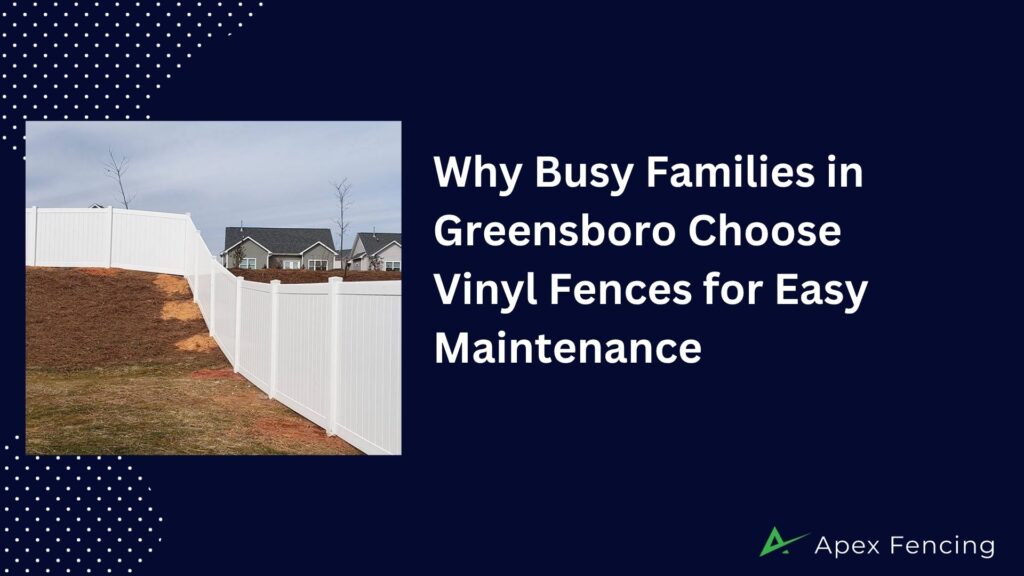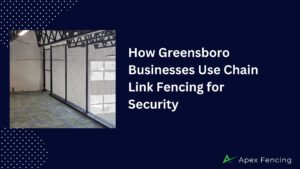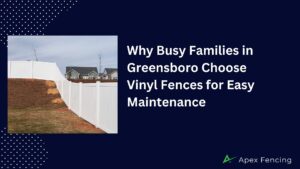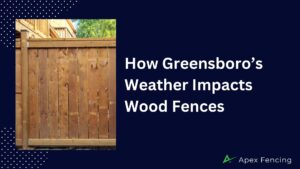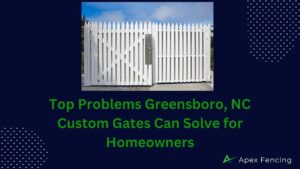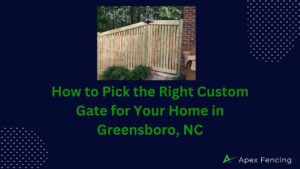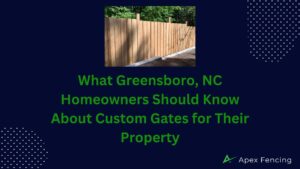Vinyl fences give you the low-maintenance, family-friendly privacy you need in (location) — a humid subtropical area with hot summers, frequent rain, and attractions like the Greensboro Arboretum and Bicentennial Garden — so you avoid rot, insect damage, and mold; as one of the top low-maintenance fences and family-friendly fences, vinyl (PVC) is long-lasting, keeps your kids and pets safe, saves time versus wood, and pairs with local vinyl fence installation for the best lifetime value and durability for vinyl fence Greensboro NC.
Key Takeaways:
- Vinyl fences offer true low-maintenance family living in Greensboro, NC — PVC/picket and privacy styles stay fade- and stain-free, are pet-safe and child-safe, and require only occasional washing rather than seasonal sealing or painting.
- Built for Greensboro’s humid subtropical climate — year-round rain, high humidity, hot summers and occasional storms across the Piedmont Triad — vinyl resists rot, insect damage, mildew and warping better than wood, keeping yards near the Greensboro Arboretum, Bog Garden, UNCG or Coliseum looking tidy with less upkeep.
- Superior lifetime value and local expertise: lower long-term costs versus wood (no repeated staining/repairs), strong curb appeal for busy parents and professionals, and better results when installed by local teams who understand Greensboro NC codes, HOA rules and site conditions.
Understanding Vinyl Fencing
Your Greensboro yard benefits from vinyl fencing that resists rot, insects, and year-round weathering, so you avoid seasonal staining or sealing in the humid subtropical climate. You get privacy, curb appeal, and a surface that wipes clean after summer storms near the Bog Garden or rains by I-40, keeping maintenance minimal for busy families juggling school and activities.
Types of Vinyl Fencing
Common vinyl profiles fit different needs: tall solid panels for backyard privacy, picket styles for curb appeal, semi-private panels for airflow, ranch rails for property lines, and ornamental panels for front-yard accents. You choose styles that match your home near downtown Greensboro or neighborhoods around UNCG while keeping upkeep low.
- Privacy vinyl – 6–8 ft solid panels for sound reduction and seclusion
- Picket vinyl – 3–4 ft decorative boards for front-yard charm
- Semi-private vinyl – spaced slats for airflow and partial sightlines
- Ranch/rail vinyl – 2–3 rail systems for defining large yards
- Ornamental vinyl – lattice or post-cap styles for architectural detail
| Privacy | Backyards, pools; blocks sight and sound |
| Picket | Front yards, gardens; classic curb appeal |
| Semi-private | Yards needing airflow, partial screening |
| Ranch/Rail | Pastures, large lots; boundary definition |
| Ornamental | Accent areas, porches; decorative detail |
Recognizing the right profile for your lot and lifestyle helps you balance privacy, pet safety, and low upkeep.
Vinyl vs. Other Fencing Materials
Vinyl outperforms wood in Greensboro’s humidity by avoiding rot and insect damage, and it needs no annual staining; compared with chain-link it gives you privacy, while aluminum offers similar corrosion resistance but at higher upfront cost for ornate designs. You save time and often money over a 20–30 year span because vinyl requires only occasional cleaning after summer storms or pollen seasons.
Concrete numbers help: typical installed costs run about $20–$40 per linear foot for basic vinyl privacy, $15–$30 for new wood (plus staining every 2–3 years), $8–$20 for chain-link, and $25–$45 for aluminum; vinyl’s low maintenance and warranties often produce a lower lifetime cost even if initial spend is moderate.
Key Features of Vinyl Fencing
Expect low-maintenance surfaces, UV-stable formulations that resist fading in summer sun, waterproof construction that handles Raleigh–Greensboro humidity shifts, and smooth edges safe for kids and pets. You’ll appreciate warranties of 20+ years from reputable manufacturers and quicker installation by local contractors familiar with Greensboro soils and permitting.
- Low-maintenance – cleans with soap and water, no staining
- Weather-resistant – withstands rain, humidity, and sun exposure
- Durability – resists rot, warping, and insect damage
- Safety – splinter-free boards, smooth rails for children and pets
- Warranty-backed – many manufacturers offer 20–30 year guarantees
This combination of features reduces seasonal chores so you keep weekends free for family time at places like the Greensboro Arboretum.
Further detail: pick thicker vinyl profiles (0.135–0.190 in wall thickness) and UV-stabilized compounds for longer life; post-setting in concrete with proper drainage prevents frost heave in winter and ensures panels stay straight through Greensboro’s temperature swings. Local installers should confirm line-of-sight, HOA rules near Fisher Park, and gate hardware compatibility for pets and strollers.
- Profile thickness – heavier walls improve rigidity and lifespan
- UV stabilization – prevents chalking and color loss
- Reinforced posts – steel inserts or concrete setting for wind resistance
- Easy-clean finish – resists mildew and pollen staining
- Child- and pet-safe – no splinters, smooth latches and gates
This guidance helps you specify materials and installation practices that match Greensboro’s climate and your family’s routine.
Benefits of Vinyl Fences for Busy Families
Low Maintenance Requirements
You save time with vinyl because it never needs staining or painting and typically only requires a quick wash once or twice a year. Vinyl resists rot and insect damage that forces wood owners to spend hours sealing or replacing boards; in Greensboro’s humid subtropical climate—about 45 inches of annual rain and summer highs near 90°F—vinyl holds appearance far longer, giving you back weekends for family, school runs, and activities.
Safety Features for Children and Pets
Vinyl eliminates splinters and sharp, rotting edges that can injure kids or pets, and solid panels provide secure privacy and containment for play areas. You can choose picket spacing, gate hardware, and heights that match your family needs so your dog or toddler stays inside and neighbors enjoy the view.
Choose self-closing, self-latching gates and picket gaps under 2 inches to prevent small pets from squeezing through; many vinyl systems come with reinforced rails and optional aluminum stiffeners to resist pushing and jumping. Local installers in Greensboro will set posts in concrete to handle clay soils and proper drainage near places like Lake Brandt or downtown gutters, reducing leaning and gaps that create escape points.
Durability Against Weather Elements
Vinyl stands up to Greensboro’s cycles of rain, humidity, and sun without warping, rotting, or insect damage common to wood; UV-stabilized formulations reduce fading so color lasts. Expect a well-made vinyl fence to maintain structural integrity for 20–30 years, making it a low-hassle choice for families juggling work, school, and extracurriculars.
High-grade vinyl with UV inhibitors and reinforced rails resists cracking in hot summers and freeze-thaw cycles; many manufacturers offer 20–25 year warranties. Compared to wood that often needs sealing every 2–3 years and replacement within 10–15 years in humid climates, vinyl delivers better lifetime value when paired with professional Greensboro installation that accounts for local soil, rainfall runoff, and wind exposure near I-40 corridors and residential neighborhoods.
Choosing the Right Vinyl Fence
Assessing Your Home’s Style
Match fence style to your home’s architecture—choose a 3–4 ft picket for Colonial or Craftsman fronts and a 6 ft solid panel for ranch or brick homes in neighborhoods near UNCG or Fisher Park. White or off-white vinyl complements historic facades, while tan or gray pairs with brick and stucco. Many Greensboro families pick a low-maintenance vinyl that echoes wood grain for curb appeal without seasonal staining, saving you hours each year compared with wood fences.
Privacy vs. Aesthetics
Opting for a 6 ft solid vinyl panel gives your backyard true privacy for kids and pets, while a 4 ft shadowbox or picket fence preserves sightlines and curb appeal on streets like Wendover or College Hill. Solid panels block wind and noise but can reduce airflow; in Greensboro’s ~45 in/year rainfall and high humidity, that decreased ventilation can increase moisture buildup if posts and gates aren’t properly installed.
Balance by choosing designs with integrated ventilation—shadowbox, lattice tops, or spaced pickets—that let air circulate and cut mildew risk while keeping fences tall enough for a secure play area. Most local ordinances allow up to 6 ft in backyards and 4 ft in front yards, so you can often get full privacy where you need it and openness facing streets like Elm Street or Friendly Avenue; consult a local installer to verify setback and sight-line rules.
Customization Options
Vinyl offers color choices, wood-grain textures, post cap styles, and gate hardware so you can tailor function and look—add a self-closing gate and dog-proof latches for safety, or a lattice top for light and style. UV-stabilized vinyl resists fading in Greensboro’s hot summers, delivering long-term curb appeal with minimal upkeep compared to painted wood.
Families often upgrade with reinforced rails and stainless-steel hardware to withstand humidity and active use; expect premium options like textured boards or privacy inserts to add roughly $5–$10 per linear foot but extend useful life. Avoid low-grade PVC that can warp in heat—choose products with warranty coverage and local installation from experienced crews to ensure lasting performance.
Installation Tips for Vinyl Fencing
- vinyl fence Greensboro NC
- low-maintenance fences
- family-friendly fences
- Vinyl fence installation
Preparing the Site
Mark your property line with stakes and a string line, verify setbacks with local zoning, and call 811 to locate buried utilities before digging. Clear brush and root masses, grade for 1–2% drainage away from foundations—Greensboro’s humid summers and heavy rain demand good runoff—and set post locations typically every 6–8 feet for standard panels.
Tools Needed for Installation
Gather a post hole digger or power auger, 4-foot level, heavy-duty tape measure, string and stakes, cordless drill with driver bits, circular saw for trimming panels, concrete mix, gravel, and safety gear; mark power auger and concrete mixing as dangerous tasks requiring care and PPE.
Extra detail: rent a 6–8 in. auger for faster holes (typical post hole 30–36 inches deep in the Piedmont for stability), bring a tamper for compacting gravel, and use a square and carpenter’s level to keep rails plumb—this reduces wiggle and extends the fence life against Greensboro’s sun and humidity.
| Tools & Purpose | |
|---|---|
| Power auger / post hole digger | Speed and consistent hole depth (30–36 in.) |
| 4-foot level & line level | Ensure posts and rails are plumb and even |
| Cordless drill & saw | Cut panels, fasten brackets, install hardware |
| Concrete mix & gravel | Secure posts and improve drainage |
Step-by-Step Installation Guide
Set end and corner posts first, run a tensioned guide line, dig holes to 30–36 inches, add 4–6 inches of gravel, set posts with concrete and check plumb, allow 24–48 hours curing, attach rails and panels (typically 6 ft wide), and fit gates with hardware rated for frequent family use to withstand kids and pets.
Additional info: space posts at 6–8 ft depending on panel type, brace corners during curing for true alignment, use stainless steel fasteners to resist corrosion in Greensboro’s humid climate, and pick UV-stabilized vinyl to avoid warping in summer sun.
| Step & Detail | |
|---|---|
| Layout | Stake line, measure property, confirm setbacks and permits |
| Dig & Set Posts | 30–36 in. deep, 4–6 in. gravel base, concrete to grade |
| Attach Rails/Panels | Use manufacturer brackets, maintain level, allow expansion gaps |
| Install Gates | Heavy-duty hinges, check swing clearance, latch safety for kids |
Thou should contact a local installer for permit assistance, precise grading near slopes and curbs, and an on-site estimate to ensure the best long-term value for your family.
Maintenance Essentials for Vinyl Fences
Routine upkeep for a vinyl fence in Greensboro is straightforward: wash, inspect, and address small issues before they grow. You’ll deal with spring pollen, summer humidity, and occasional storms from the Piedmont region near Lake Brandt and the downtown corridor; vinyl resists rot and insects far better than wood, so your time investment is minimal compared with staining or sealing. Schedule basic checks twice a year and contact local pros via vinyl fence installation or fence repair pages when needed.
Cleaning Your Vinyl Fence
Mix mild dish soap with water and use a soft brush or a garden hose to remove pollen and dirt after spring blooms or weekly rains; for mildew, apply a 1:3 vinegar-to-water solution or a bleach-free cleaner. Avoid abrasive pads and keep pressure washers under 1,200 PSI and 20° nozzle angle to prevent surface damage. You can usually clean thoroughly in 20–30 minutes for an average yard.
Inspecting for Damage
Scan posts, panels, and gates for movement, hairline cracks, or loose fasteners after heavy storms or freeze-thaw swings; check gate latches and hinges for sagging and ensure panels remain aligned along property lines near parks like Country Park. Small flex or chalking is cosmetic, but anything showing structural shift deserves attention.
Look for telltale signs that indicate structural problems: posts sinking more than an inch, horizontal gaps widening beyond ½ inch, or panels splitting at corners from UV stress. Photograph issues and compare against warranty terms before repairs; local installers familiar with Greensboro’s humid subtropical climate can often re-set posts in concrete or replace panels quickly.
- vinyl fence Greensboro NC
- low-maintenance fences
- family-friendly fences
Any sign of post rotation, gate sag, or widening gaps should prompt a call to a local fence specialist to protect warranty and safety.
Seasonal Maintenance Tips
Plan light maintenance with the seasons: deep-clean in spring to remove pollen, tighten hardware and check gates before summer activities, clear leaves in fall to prevent mildew, and inspect after rare winter freezes. Greensboro’s hot summers and humid springs mean you can usually skip annual staining—vinyl keeps curb appeal with minimal effort, which fits busy family schedules and usage by kids and pets.
Adopt a simple seasonal checklist: wipe down panels in March, lubricate hinges in June, clear debris in October, and inspect after any winter cold snap; track dates and photos so you spot gradual changes. Prioritize materials and installation quality—good posts and UV-stabilized vinyl last decades, lowering lifetime costs compared to wood.
- vinyl fence Greensboro NC
- low-maintenance fences
- fence repair Greensboro
Any major replacement or structural work should be scheduled with a local installer to maintain warranties and long-term value.
Factors to Consider Before Installing
Match fence height and style to each yard’s use: a 3–4 ft picket for curb appeal, a 6 ft privacy panel for backyard play, and 6–8 ft post spacing for stability in Greensboro’s humid subtropical climate where you see ~45 inches of annual rain and hot summers near 90°F; choose UV-stabilized, commercial-grade vinyl to avoid warping and staining and factor in local installation quality for longer life. Recognizing how vinyl fence Greensboro NC performs against rot, insects, and humidity will help you plan effectively.
- Low-maintenance fences: select PVC with UV inhibitors to resist yellowing.
- Site prep: confirm drainage, slopes, and buried utilities before digging.
- Materials: heavier gauge rails and metal-reinforced posts boost lifespan to 20–30+ years.
- Local pros: hiring a Greensboro installer reduces permit headaches and ensures proper footings.
Budgeting for Vinyl Fencing
Expect installed costs roughly $20–40 per linear foot for privacy vinyl and $15–30 for picket styles, with premium materials and reinforcements raising prices; compare that to wood’s typical 7–15 year lifecycle versus vinyl’s 20–30+ year lifespan to calculate lifetime value. Include excavation, concrete footings, gates (usually $150–$600 each), and any permits in your estimate so you won’t face surprise expenses.
Local Regulations and Permits
Check Greensboro city codes, Guilford County rules, and HOA covenants for height limits, setback requirements, and historic-district restrictions before ordering panels; many areas require a simple fence permit and a plotted site plan showing property lines and existing structures. Contact City of Greensboro Permit Services or your HOA early to avoid delays and plan fence placement around utility easements.
Many Greensboro neighborhoods commonly allow about 4 ft in front yards and up to 6 ft in rear yards, though variations exist—HOAs near places like the Greensboro Arboretum or Lindley Park may have stricter design guidelines. Submit a scaled site plan with post locations, gate swings, and finished elevations; expect 1–3 week review times for routine permits and longer for variances. Failing to secure approvals can force partial removal, so confirm setback measurements with a surveyor or the county GIS before installing.
Space and Layout Considerations
Plan gate widths for lawn equipment (3–4 ft minimum), set posts on 6–8 ft centers for standard panels, and choose step or racked panels for slopes—avoid long runs without intermediate posts where wind load from Greensboro storms can cause bowing. Position gates and latches for easy child- and pet-safe access and account for swing clearance and driveway sightlines.
For slopes greater than about 6 inches over an 8 ft panel, use stepped panels or custom-cut bottoms to maintain a neat line and prevent gaps that small pets can squeeze through. Reinforce corners and end posts with concrete footings (12–18 in diameter, 24–36 in deep depending on frost line and soil) and consider stainless-steel hardware near Lake Brandt or other humid spots to limit corrosion. Discuss site-specific solutions with a local installer experienced in Greensboro terrain and microclimates.
Pros and Cons of Vinyl Fences
| Pros | Cons |
|---|---|
| Low maintenance — no staining or painting | Higher upfront cost than chain-link |
| Resists rot and insects, ideal for Greensboro’s humidity | Can fade or yellow over years in strong UV |
| Durable in rain and heat (Greensboro averages ~45″ annual rain) | May crack on heavy impact or severe freeze-thaw cycles |
| Safe for kids and pets — no splinters | Color-matching repairs can be difficult |
| Long lifespan (often 25–40+ years) | Not easily painted if you want a new look |
| Variety of styles for privacy and curb appeal | Some find vinyl less “natural” than wood |
| Easy cleaning with a hose or pressure washer | Environmental concerns around PVC disposal |
| Consistent appearance boosts resale near areas like Guilford Courthouse | Poor installation can cause sagging or warping |
Advantages of Vinyl Fencing
You get minimal upkeep—no annual staining—and a fence that stands up to Greensboro’s humid summers and frequent rain; manufacturers often quote 25–40 years of service, letting you spend weekends on family activities instead of maintenance.
Potential Disadvantages to Consider
Upfront costs can be higher than basic options, and you may face fading, cracking, or color-match issues over decades; choose materials and installers carefully so you don’t trade short-term convenience for long-term headaches.
Impact resistance varies by grade: lower-cost PVC can become brittle in temperature swings, while premium formulations with UV stabilizers hold up better under Greensboro summer sun and near busy streets like Battleground Avenue; request warranties and samples so you can see colorfastness and flexibility before committing.
Long-Term Value Analysis
Vinyl often offers a better lifecycle cost than wood if you factor in savings on paint, sealant, and repair; over 20 years, reduced maintenance and reliable privacy can offset the higher initial investment for busy families in Greensboro.
Local installation matters: a correctly set post and quality-grade PVC with UV inhibitors preserve value near neighborhoods like Lindley Park and Forest Oaks; compare quotes, check references, and view completed jobs—refer to vinyl fence installation and fence maintenance pages for service details and warranty options.
Enhancing Your Yard with Vinyl Fences
Vinyl fencing frames your yard with minimal upkeep while boosting curb appeal along Greensboro streets near UNCG, the Bog Garden, or Friendly Avenue. You get privacy, durability, and a clean look without seasonal sealing—vinyl resists rot, insects, and UV fade in the city’s humid subtropical climate, making it ideal for busy families who want a long-lasting boundary that still showcases landscaping and sightlines to neighborhood parks and schools.
Landscaping Ideas and Integration
Plant low-maintenance shrubs like boxwood, hydrangea, or crepe myrtle in 2–3 foot mulched beds against a 4–6 ft vinyl privacy panel to soften lines and add color through Greensboro’s rainy spring months; use a lattice-top panel for climbing jasmine or clematis, and add solar path lights every 8–10 feet to highlight paths to patios or play areas. Vinyl won’t rot from irrigation, so you can mulch and irrigate freely.
Pairing with Gates and Accessories
Choose a 3–4 ft single gate or 5–6 ft double gate with stainless-steel or powder-coated hardware, self-closing hinges, and childproof latches to keep kids and pets safe while giving you keypad or smart-lock options for easy access between work, school drop-offs, and activities; double gates simplify mowing and equipment access.
Specify posts set into concrete footings—typically 30–36 inches deep in Greensboro soils—for stable gate operation and to resist seasonal wetting from average annual rainfall (~45 inches). Opt for stainless or galvanized fasteners to avoid corrosion in humid conditions, and request installers preload spring hinges for self-closing action; a 3-ft single gate generally runs about $200–$600 installed, while double gates start around $600–$1,200, depending on hardware and automation.
Color and Design Options
Pick from classic white, tan, gray, or wood-grain textures for a look that matches your home’s siding or trim—privacy panels, shadowbox, picket, and ranch-rail styles offer different levels of openness and curb appeal. Many manufacturers include UV-resistant finishes and 20–30 year warranties, so you won’t need to repaint or stain to maintain color through Greensboro’s hot summers and humid seasons.
Custom colors and embossed wood-grain finishes add curb appeal near historic districts or newer developments; expect specialty colors to add roughly 10–20% more to material costs. Ask local installers for color swatches and digital mockups to match your roof or shutters, and confirm panels have UV stabilizers so pigments stay consistent over decades—cleaning with soap and water typically keeps the finish like-new. For a design consult, visit design consultation.
Comparing Vinyl Fencing to Wood Fencing
Vinyl vs Wood: Quick Comparison
| Vinyl | Wood |
|---|---|
| Low upkeep: soap & water cleaning; resists rot and insects | High upkeep: sealing/staining every 2–3 years; susceptible to rot |
| Lifespan: 25–40+ years; often 20–30 year warranties | Lifespan: 10–20 years with maintenance; shorter in humid climates |
| Upfront cost: higher; better life‑cycle value | Lower upfront; higher lifetime maintenance costs |
| Styles mimic wood; no splinters—good for kids/pets | Authentic wood grain and staining options; natural look |
Maintenance Needs
You’ll spend minutes, not weekends, on vinyl: routine rinses or a quick scrub remove pollen and mildew common after Greensboro rains and humid summers. Wood fences demand sanding, sealing or painting every 2–3 years to prevent rot, insect damage, and warping from the Piedmont Triad’s humidity. Choosing vinyl reduces seasonal chores and eliminates splinter hazards for kids and pets.
Longevity and Cost Effectiveness
Expect vinyl to last 25–40 years with minimal upkeep while wood often needs major repairs or replacement within 10–20 years without steady maintenance; that shifts the real cost in vinyl’s favor for busy families in Greensboro. Warranties of 20+ years on quality vinyl translate into lower lifetime expense compared with regular staining and board replacement.
Installed prices in Greensboro typically range: vinyl about $25–$45 per linear foot, wood roughly $15–$30. Add recurring sealing/repair costs for wood—every few years—that can equal or exceed vinyl’s higher initial investment within 10–15 years. Local installers using high‑grade vinyl (thicker rails, UV stabilizers) and proper footing for clay soils around Lake Brandt or Greensboro neighborhoods extend performance and protect your long‑term value.
Aesthetic and Natural Considerations
You can get crisp privacy panels, picket styles, or wood‑grain textures in vinyl to match Greensboro homes around Friendly Center or the Arboretum, while avoiding splinters and frequent repainting. Wood offers a natural look and staining flexibility but requires constant upkeep to keep that appearance in the city’s sun and humidity; vinyl maintains color and shape with little intervention.
Manufacturers add UV inhibitors and fade warranties (often 10–20 years) so vinyl holds its finish under hot summers and strong sun exposure. Wood may need sanding and restaining after mildew or sun bleaching; pressure‑treated lumber resists insects but still rots over time in damp conditions. For family yards, vinyl’s smooth surface is safer for children and pets and keeps curb appeal consistent with less effort.
Popular Vinyl Fencing Styles
You’ll find three vinyl styles dominating Greensboro yards: privacy for backyard seclusion, classic picket for curb appeal, and semi-private for airflow plus screening. Each style resists rot, insects, and the region’s ~45 inches of annual rain, so you trade seasonal sealing for occasional rinsing. Many local manufacturers back products with 20–30 year limited warranties, giving you long-term value that fits busy family schedules and local installers who understand Piedmont soil and wind patterns.
Privacy Fences
Full-panel privacy fences commonly run 6 feet high with tongue-and-groove or solid-panel designs that block sightlines around pools, play areas, and AC units near the Greensboro Arboretum. Vinyl panels won’t warp or rot in humid summers and handle heavy rain without staining, so you avoid annual sealing and repainting. Local installers set posts deeper to prevent leaning in Piedmont clay, and many homeowners see lower lifetime costs versus wood because of reduced maintenance and replacement needs.
Picket Fences
Picket vinyl fences usually sit 3–4 feet tall with 2–4 inch spacing, giving you front-yard charm along streets like Friendly Avenue while keeping small pets contained. You get the traditional white or cream look without scraping and repainting—just a hose-off maintenance routine—so curb appeal stays intact with minimal effort. Many families choose PVC pickets for visibility to watch kids at play while preserving neighborhood aesthetics.
Specs matter: common picket profiles use .08–.12-inch PVC wall thickness and galvanized steel-reinforced rails for strength; those features reduce sagging and extend service life. You can add caps, post lights, or gate latches that meet pool-code safety. Comparing costs, vinyl pickets typically cost more upfront than pine but deliver lower total cost of ownership over 15–25 years because you skip repainting and frequent repairs—important if your schedule is already packed with school runs and youth sports.
Semi-Private Fences
Semi-private vinyl fences blend privacy and ventilation with staggered or partially spaced pickets at heights of 4–5 feet, ideal for yards where airflow helps lawn and garden health during humid summers. The design limits visibility but still allows breezes from Lake Brandt or summer storms to pass through, reducing wind load on panels. With low upkeep and resistance to mildew and insect damage, semi-private choices suit families who want seclusion without trapping moisture against plant beds.
Design options include overlapping rails, shadowbox profiles, and decorative lattice tops for added light. Proper post footings—typically 30–36 inches deep in Greensboro’s clay—ensure durability through seasonal freeze-thaw cycles and storm gusts. Many homeowners pair semi-private panels with gate hardware rated for frequent use, giving you a family-friendly combination of privacy, ventilation, and long-term value.
Finding the Right Fencing Contractor
Choose a contractor who is licensed and insured in Guilford County, offers a written contract and local references, and can show 20–30 year material warranties for vinyl. You want someone familiar with Greensboro’s humid subtropical weather, local permitting near downtown or neighborhoods like Lindley Park, and who uses UV-stabilized, ASTM-rated vinyl.
What to Look for in a Contractor
Verify proof of liability and worker’s comp, written estimates with line-item pricing, and clear timelines—typical vinyl installs in Greensboro run $25–$45 per linear foot installed. Check that posts will be set in concrete footings, gates use corrosion-resistant hardware, and materials are specified as UV-stabilized and impact-resistant. Ask for a sample panel and confirm the installer follows local grading and drainage practices to prevent settling after heavy rains.
Questions to Ask During Consultation
Ask for a full cost breakdown, expected start-to-finish timeline, permit handling, gate hardware brands, and whether the warranty covers fading, cracking, and labor. Request details on how they handle slopes, drainage, and root systems common in Greensboro yards, plus cleanup and inspection steps. Confirm whether subcontractors will be used and get a written change-order process to avoid surprise fees.
Probe warranty specifics: ask who pays for labor on repairs, how long color retention is guaranteed, and whether the warranty transfers if you sell your home. Request to see product data sheets for UV ratings and impact tests, and insist on proof of recent insurance and licensing. If you can, get three written bids and a projected completion date tied to penalties for delays to keep your family’s schedule on track.
Evaluating Past Work and Reviews
Check Google, Yelp, and BBB ratings, and ask contractors for a portfolio of recent Greensboro jobs with photos from installation and 3–5 years later. Look for consistent post alignment, tight gate latches, and no sagging; read reviews for responsiveness to warranty claims and hidden fees. High-rated local reviews and clear before/after photos often indicate reliable work that withstands our rain, humidity, and summer sun.
Visit at least one completed job or speak with two customer references from the past 12 months to verify workmanship and durability. Inspect the spacing of posts, concrete footing depth, and gate operation in person; test how panels look in direct sun near Interstate 40 corridors or shady lots by Bog Garden. Seeing an installation in your climate is the best proof the contractor stands behind their work.
Local Considerations for Greensboro
Greensboro’s humid subtropical weather, with roughly 45 inches of annual rainfall, hot summers and year-round humidity affects fence performance more than curb appeal alone. You’ll find vinyl fencing resists rot, insect damage, and weathering far better than wood around Lake Brandt, UNCG, and neighborhood streets, so busy families spend less weekend time on upkeep. Check local installers and material options on our vinyl fence services page to match durability with style in (Greensboro).
Climate Impact on Fencing Choices
Greensboro’s summer highs in the upper 80s and frequent humidity accelerate wood decay and mold growth, making rot and insect infestation common problems for untreated timber. Vinyl offers UV-stabilized formulations and non-porous surfaces that avoid staining, sealing, and frequent inspections, so you won’t be repainting after a wet spring or chasing warped boards following humid months.
Community Regulations and Trends
Many Greensboro neighborhoods, including historic areas like Fisher Park and Irving Park, enforce design standards and HOA rules that limit fence height, color, and materials; HOA rules and city permits often determine whether a 6‑foot privacy fence or picket style is allowed. You should review HOA covenants and the City of Greensboro guidelines before ordering materials to avoid costly rework.
Permit requirements typically ask for a simple site sketch showing property lines, setbacks, and proposed fence height; 6-foot rear-yard privacy fences are commonly acceptable while front-yard rules are stricter. Local trends favor low-maintenance vinyl styles that mimic wood grain to meet aesthetic guidelines, and submitting materials samples with your application speeds HOA or municipal approval.
Engaging with Local Experts
Choosing licensed, insured local installers familiar with Piedmont clay soils and Greensboro sightline rules prevents common problems like leaning posts or permit delays. Ask for projects near the Coliseum or Lindley Park, verify warranties on profiles and installation, and compare at least three estimates to balance upfront cost with long-term performance.
Local experts will perform a site survey, mark utilities (call 811), recommend concrete footings and aluminum-reinforced rails for wind resilience, and tailor profiles to HOA standards; vinyl typically costs 20–30% more upfront than pressure-treated wood but can last 2–3 times longer, improving lifetime value. Learn more or schedule a consultation on our installation and contact pages.
Testimonials from Greensboro Families
Positive Experiences with Vinyl Fences
Neighbors in Lindley Park and near the Greensboro Science Center report that vinyl fences cut seasonal upkeep from hours to minutes—no staining or annual sealing—so your weekends stay free for Little League or events at LeBauer Park. Many note the fence held up through storms and Greensboro’s 45 inches of annual rainfall, keeping pets and kids secure while maintaining curb appeal for 20+ years.
Overcoming Initial Hesitations
Several families worried about the higher upfront price but found installer quotes and material warranties eased concerns; installers explained that quality vinyl rarely warps or attracts termites like wood does in humid Greensboro. You’ll often get a 20–30 year lifespan and a transferable warranty, which helped most decide the long-term value outweighed initial cost.
Local case studies show typical vinyl quotes 10–30% higher than pressure-treated wood, but homeowners in Irving Park who totaled costs over 15 years saw vinyl’s lower maintenance drop lifetime expenses by roughly 40–60%. Ask contractors for line-item estimates, warranty terms, and examples of past jobs near UNCG or the Piedmont Triad to confirm resilience against humidity and summer heat.
To wrap up
For busy families in Greensboro, NC, a vinyl fence is more than just a boundary — it’s peace of mind. In a city with hot, humid summers, steady rainfall, and active neighborhoods, vinyl stands out as the low-maintenance, family-friendly solution that keeps your yard safe, private, and attractive year-round.
Unlike wood, which demands constant sealing and repairs, vinyl resists rot, mildew, and insect damage while maintaining its clean look with just an occasional wash. That means more time for soccer practice, weekend trips to the Greensboro Arboretum, or simply enjoying your backyard — and less time worrying about fence upkeep.
When you weigh lifetime value, durability, and curb appeal, vinyl fences consistently prove to be a smart investment for parents, pet owners, and professionals who need reliability without the extra work.
👉 The next step? Partner with a local fence expert who understands Greensboro’s climate, soil, and HOA guidelines. For trusted vinyl fence installation that saves you time and keeps your yard looking great, Apex Fencing is here to help.

